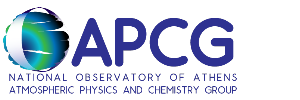
Spatial distribution of: (a) average concentrations (μg m-3) of total carbon (TC), (b) average concentrations (μg m-3) of nitric monoxide and dioxide (NOx), c) average concentrations (ppb) of total ozone column (O3) and d) direct effect of aerosol on total surface radiation (W m-2), during the summer 2007 wildfire event in Peloponnese, Greece (COSMO-ART applications during 22 August – 02 September, Athanasopoulou et al., 2014).
Members of the APCG group are involved with atmospheric model applications. In particular, they performe gas and aerosols simulations with the regional atmospheric model COSMO-ART. COSMO-ART is a regional atmospheric model (ART stands for Aerosols and Reactive Trace gases), developed by the ‘Aerosols, Trace Gases and Climate Processes’ Group of the Institute for Troposphere Research, Karlsruhe Institute of Technology (KIT), Germany (Vogel et al., 2009). The model is online-coupled to the COSMO regional numerical weather prediction and climate model (Baldauf et al., 2011) of the German Weather Service (DWD). The processes of emissions, gas and aerosol chemistry, coagulation, condensation dry deposition, sedimentation and washout are taken into account.
COSMO-ART applications of APCG group use the anthropogenic emission database TNO-MACCII, processed by EMPA (Switzerland) under an MoU with NOA. Meteorological data and support is provided by the German Weather service (DWD). Meteorologically-affected emissions (ssa-salt, dessert dust and biogenic emission) are online-coupled to the model system (Vogel et al., 1995; 2006; 2009). The online coupling allows for feedbacks of aerosols on temperature, radiation and cloud condensation nuclei (Vogel et al., 2009; Bangert et al., 2011; Bangert et al., 2012; Athanasopoulou et al., 2012).
COSMO-ART applications of APCG group currently cover the greater area of Greece, centered at the city of Athens. Applications are supported by computational time granted from the Greek Research & Technology Network (GRNET) in the National HPC facility – ARIS. Parallel support from the HPC KIT system exists. The model domain chosen for APCG applications is the greater area of Greece, centered on the city of Athens. The horizontal resolution is 0.025 deg. and the vertical extend of the domain reaches ~20 km (60 layers). Up to present, APCG applications cover 3 selected cases: (a) the extreme wildfires of 2007 (Athanasopoulou et al., 2014), (b) the smog episodes of winter 2013-’14 (Athanasopoulou et al., 2016, in prep), and (c) September 2015, during the first citizen observatory campaign in Greece (iSPEX campaign; Athanasopoulou et al., 2016, accepted for publication in Springer).

